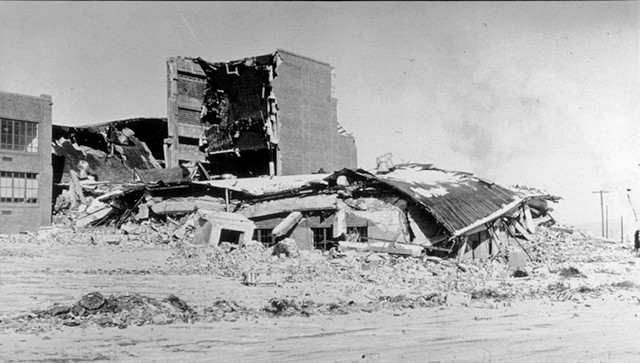
by Bethany Augliere Tuesday, December 27, 2016

In 1935, Helena High School collapsed following a major aftershock of a magnitude-6.2 earthquake in Helena, Mont. Credit: NOAA/NGDC.
Earthquake aftershocks may be more unpredictable than previously thought. Researchers studying past quakes say they have identified a new class of aftershocks that can occur within seconds to minutes after the mainshock on neighboring faults.
The results are important as they mean “that earthquakes jump from fault to fault more, perhaps, than realized,” and that they don’t occur only on connected faults, says Peter Shearer, a geophysicist at Scripps Institution of Oceanography and co-author of the new study published in Science. The findings don’t necessarily change the overall seismic hazard of a region, Shearer says, but they are important to consider for future fault models.
Shearer’s graduate student, Wenyuan Fan, analyzed 88 recorded earthquakes from seismometers around the world, ranging from magnitude 7 to 8 that occurred between 2004 and 2015, employing a technique known as back-projection to look for previously undetected aftershocks.
Back-projection involves focusing the seismic waves that pass through a seismometer array back in space and time to determine the original timing and location of the quake. “You basically run time in reverse,” Shearer says.
Using data collected from global seismic stations, Shearer and Fan found 48 previously undetected aftershocks that occurred between 50 and 300 kilometers from mainshock epicenters and within 200 seconds of the mainshock.
The early aftershocks occurred in 27 of the 88 earthquakes studied, or about 30 percent. “These [aftershocks] weren’t in the catalogs — the standard earthquake catalogs that are produced by the U.S. Geological Survey or other agencies; these were new,” Shearer says, which means “this is a relatively common phenomenon.” These close-proximity and subsequent aftershocks on different faults must happen often, he says.
Two types of stress propagation — static and dynamic — can trigger aftershocks. Changes in static stress, arising from permanent displacement on an earthquake fault, can trigger aftershocks close to a mainshock. On the other hand, more distant triggering is caused by dynamic effects, as seismic waves traveling over long distances temporarily change the stresses on a fault as the waves pass by. In the new study, the researchers suggest that these nearby aftershocks were likely dynamically triggered.
Finding “this class of early aftershocks that do appear to be dynamically triggered” doesn’t indicate “that all events in aftershock sequences are dynamically triggered, so that’s still going to be a subject of ongoing research,” Shearer says.
Additionally, the aftershocks were not restricted to a specific type of fault. Sixteen aftershocks occurred on reverse faults, four on strike-slips faults, and seven on normal faults. But Shearer points out that normal-faulting mainshocks triggered early aftershocks at a higher rate — 50 percent of the time — than quakes on other types of faults.
“It was interesting that all these aftershocks happened and we had no idea because they are hard to spot,” says John Vidale, a seismologist at the University of Washington who was not involved in the study. “It’s a pretty impressive piece of work.”
The study has important implications for hazard management, Vidale says. The aftermath of an earthquake is dangerous, “and now we can see the activity that comes right after these big, potentially devastating earthquakes,” Vidale says. “We shouldn’t get too obsessed trying to guess where the next earthquake is likely going to be after an earthquake — it can be anywhere in the area.”
© 2008-2021. All rights reserved. Any copying, redistribution or retransmission of any of the contents of this service without the expressed written permission of the American Geosciences Institute is expressly prohibited. Click here for all copyright requests.